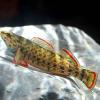Need help!
#1

Posted 06 November 2024 - 09:50 PM
#2

Posted 07 November 2024 - 07:12 AM
Your fish likely have ich. It is a very common, external parasite and what you're seeing is the encysted part of their life cycle. Those little white capsules will burst open and the next wave of infection can spread through the water column. And it spreads very fast. Good news is that it is very easy to treat w/o any special medications. Common aquarium salt will do the trick.
If you have live plants, the salt will most likely kill, or at the very least, stress them and cause a big leaf-drop. So you may want to discard any that you have if possible for treatment. I usually add 3ppt of aquarium salt to the system and bump the heat up. That will speed up the life cycle of ich where the salt can kill them when they become free-swimming (the little white spots are not affected by the salt). If you have a lot of substrate, gravel vac it, and perform large water changes---redosing the salt as you go. A couple weeks at 3ppt is usually enough (depending on temps.....tropical fish keepers will usually go up to the mid 80's). Your fish can handle that too, but it may not be necessary if they are just kept at ambient temp. If that is the case, just keep the salt in the system a bit longer...maybe a month.
If you need help figuring out the math for salt dosing let us know. Good luck.
#3

Posted 07 November 2024 - 08:42 AM
#4

Posted 08 November 2024 - 07:33 AM
Once it's gone, it's gone. Unless you add another, new fish that is infected. It is very prevalent in the tropical fish hobby, and often comes in on wild fish too (perhaps what happened in your case). In a closed system (fish tank) ich continues to reproduce and heavily infects the fish until it kills them. In the wild, a spot or two on them is not life threatening, especially in such a big body of water as a lake or river. You can use the OTC meds at the fish store in place of salt. To each their own. Aquarium salt is relatively cheap, and lasts forever. Good to keep on hand for other uses as well. I QX new fish with it as well.
Reply to this topic
1 user(s) are reading this topic
0 members, 1 guests, 0 anonymous users








